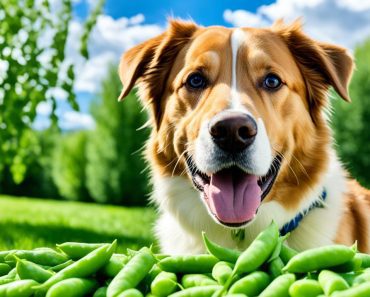As a dog owner, I understand the challenges that come with managing osteoarthritis in our furry friends. Osteoarthritis is a common and progressive disease that affects about 25% of all dogs, especially seniors and large breeds.
While there is no cure for osteoarthritis, there are strategies and care tips that can help improve your dog’s comfort and mobility. In this article, I will provide valuable information on how to partner with your veterinarian, manage your dog’s weight, incorporate exercise into their routine, and explore various treatment options.
Key Takeaways:
- Regular communication and evaluations with your veterinarian are vital for managing osteoarthritis in dogs.
- Managing your dog’s weight can alleviate joint pain, and your vet can assist in creating a customized weight-loss strategy.
- Exercise is essential, but it should be done in moderation to avoid further joint damage.
- Pain medications, nutraceuticals, and supplements can help reduce pain and improve joint health.
- Physical medicine options, such as physical rehabilitation and acupuncture, can complement traditional treatments.
Partnering with Your Veterinarian for Osteoarthritis Management
Establishing a true partnership with your veterinarian is crucial for effectively managing osteoarthritis in dogs. Regular evaluations and communication are key in monitoring the progression of the disease and modifying the treatment plan accordingly. Keeping a journal or notebook dedicated to your dog’s health can help you remember and record important information discussed during vet visits.
It is also important to follow your vet’s recommendations regarding weight management, exercise, and the use of pain medications, nutraceuticals, or supplements. Your vet may also suggest exploring physical medicine options, such as physical rehabilitation or acupuncture, to complement traditional treatments.
Regular Evaluations and Communication
Regular evaluations by your veterinarian are essential to monitor the progression of osteoarthritis in your dog. During these visits, your vet will assess your dog’s mobility, pain levels, and overall health. They may also perform diagnostic tests, such as X-rays or blood work, to get a better understanding of the disease’s impact on your dog’s joints.
Effective communication is key in ensuring that your veterinarian has a complete picture of your dog’s condition. Be sure to provide detailed information about any changes in your dog’s behavior, appetite, or mobility. This will help your vet make informed decisions about adjusting the treatment plan as necessary.
Keeping a Health Journal for Your Dog
Maintaining a health journal for your dog can be a valuable tool in managing their osteoarthritis. Use it to record important information discussed during vet visits, such as changes in medication or recommendations for weight management and exercise. Include details about your dog’s daily activities, such as the duration and intensity of exercise, any signs of pain or discomfort, and any notable improvements or setbacks.
A health journal can help you identify patterns and trends in your dog’s condition, making it easier to evaluate the effectiveness of different treatments and interventions. It can also serve as a reminder of important questions or concerns to discuss with your veterinarian during future visits.
Weight Management and Exercise Recommendations
Proper weight management plays a crucial role in managing osteoarthritis in dogs. Excess weight puts additional strain on the joints, exacerbating pain and limiting mobility. Work closely with your veterinarian to develop a weight-loss strategy that includes a balanced diet and portion control. They can recommend specific dietary options or prescription diets that are appropriate for your dog’s needs.
Regular exercise is important for dogs with osteoarthritis, but it should be done in moderation to avoid further joint damage. Consult your veterinarian for guidance on suitable exercise routines that promote joint health without causing excessive stress. They may recommend low-impact activities like swimming or gentle walks. Avoid high-impact activities that can worsen joint inflammation or lead to injury.
Exploring Physical Medicine Options
In addition to traditional treatments, your veterinarian may suggest exploring physical medicine options for managing your dog’s osteoarthritis. Physical rehabilitation, which involves therapeutic exercises and techniques, can help improve joint mobility and function. Acupuncture, chiropractic care, laser therapy, regenerative medicine, and medical massage are other possible options that can provide additional support for your dog’s joints.
| Treatment | Description |
|---|---|
| Physical Rehabilitation | Involves exercises and techniques to improve joint mobility and function. |
| Acupuncture | Insertion of thin needles at specific points to alleviate pain and stimulate healing. |
| Chiropractic Care | Manipulation of the spine and joints to improve alignment and function. |
| Laser Therapy | Use of low-level laser light to reduce inflammation and promote tissue healing. |
| Regenerative Medicine | Techniques such as stem cell therapy or platelet-rich plasma to promote tissue repair. |
| Medical Massage | Therapeutic massage techniques to improve circulation and relieve muscle tension. |
Managing Weight and Exercise for Dogs with Osteoarthritis
Maintaining a healthy weight is crucial for dogs with osteoarthritis, as excess weight puts additional strain on the joints. Working with your veterinarian to develop a weight-loss strategy and following their prescribed diet can help your dog become lean and reduce joint pain.

Regular exercise is also important for maintaining joint health, but it should be done in moderation to prevent further damage. Your veterinarian can provide guidance on the appropriate type and duration of exercise, as well as recommend joint supplements to support your dog’s joint health.
Weight Management for Dogs with Osteoarthritis
Excess weight can worsen the symptoms of osteoarthritis in dogs by putting extra stress on their joints. It is important to work with your veterinarian to develop a weight-loss strategy tailored to your dog’s needs. They may recommend a specific diet formulated for joint health or a controlled feeding plan to help your dog shed excess pounds.
Here is an example table showing the ideal weight ranges for different dog sizes:
| Dog Size | Ideal Weight Range (in pounds) |
|---|---|
| Small (less than 20 lbs) | 10-20 |
| Medium (20-50 lbs) | 20-30 |
| Large (50-100 lbs) | 30-50 |
| Giant (over 100 lbs) | 50-90 |
Exercise Recommendations for Dogs with Osteoarthritis
Regular exercise is essential for maintaining joint mobility and muscle strength in dogs with osteoarthritis. However, it is important to strike a balance between activity and rest to avoid exacerbating their condition. Your veterinarian can provide personalized exercise recommendations based on your dog’s age, breed, and overall health.
Here are some general exercise guidelines for dogs with osteoarthritis:
- Choose low-impact exercises such as walking, swimming, or controlled play sessions to minimize stress on the joints.
- Start with short exercise sessions and gradually increase the duration as your dog builds strength and endurance.
- Avoid activities that involve jumping, running on hard surfaces, or excessive twisting and turning.
- Provide rest breaks during exercise sessions and monitor your dog for signs of fatigue or discomfort.
Remember, each dog is unique, so it’s essential to consult with your veterinarian to determine the most appropriate exercise plan for your furry friend.
Pain Medications, Nutraceuticals, and Supplements for Osteoarthritis in Dogs
Pain medications, nutraceuticals, and supplements are essential components in the management of osteoarthritis in dogs. When prescribed by your veterinarian, nonsteroidal anti-inflammatory drugs (NSAIDs) can effectively reduce pain and inflammation in your dog’s joints. It is crucial to strictly adhere to the prescribed dosage and closely monitor your dog for any adverse effects.
In addition to pain medications, your vet may also recommend the use of nutraceuticals and supplements to support your dog’s joint health. These natural remedies can provide additional benefits and contribute to your dog’s overall well-being. Some common nutraceuticals and supplements include:
- Glucosamine: Glucosamine is a popular supplement known for its potential to improve joint function and relieve joint discomfort in dogs with osteoarthritis. It supports the production of cartilage and helps maintain healthy joints.
- Chondroitin: Chondroitin is another supplement that can help protect and rebuild cartilage in your dog’s joints. It works hand in hand with glucosamine to improve joint mobility and reduce inflammation.
- Green-lipped mussel extract: Derived from New Zealand green-lipped mussels, this extract is rich in omega-3 fatty acids and offers anti-inflammatory properties. It may help alleviate joint pain and improve mobility in dogs with osteoarthritis.
It is important to have a conversation with your vet about the appropriateness and safety of these supplements for your dog. Your vet can guide you in choosing the right products and provide recommendations based on your dog’s specific needs.
Remember to always follow your vet’s advice regarding pain medications, nutraceuticals, and supplements. These complementary treatments, when used alongside other management strategies, can help improve your dog’s quality of life and alleviate the symptoms of osteoarthritis.
| Supplement | Benefits |
|---|---|
| Glucosamine | Improves joint function and relieves joint discomfort |
| Chondroitin | Protects and rebuilds cartilage, improves joint mobility, reduces inflammation |
| Green-lipped mussel extract | Rich in omega-3 fatty acids, offers anti-inflammatory properties, alleviates joint pain, improves mobility |
Other Veterinary Management Options for Osteoarthritis in Dogs
In addition to traditional treatments, there are other veterinary management options that can greatly enhance the quality of life for dogs with osteoarthritis. These holistic approaches focus on providing comprehensive care and support to address the root causes of the condition.
Physical Rehabilitation
Physical rehabilitation, also known as physiotherapy, can be a valuable component of an osteoarthritis treatment plan for dogs. This specialized therapy involves exercises, manual therapy techniques, and modalities like heat and cold therapy to improve mobility, reduce pain, and promote healing. By increasing strength, flexibility, and range of motion, physical rehabilitation can help dogs with osteoarthritis regain functional abilities and enjoy a better quality of life.
Acupuncture
Acupuncture is a practice rooted in traditional Chinese medicine that involves the insertion of thin needles into specific points on the body. This ancient therapy can stimulate the release of endorphins, reduce inflammation, and improve blood circulation, all of which can provide relief for dogs with osteoarthritis. Adding acupuncture to the treatment plan can help manage pain and promote healing, providing your dog with a more holistic approach to managing their condition.
Chiropractic Care
Chiropractic care focuses on the alignment and function of the spine and nervous system. Misalignments, known as subluxations, can lead to pain, inflammation, and restricted movement in dogs with osteoarthritis. By gently adjusting the spine and joints, chiropractic care can help restore proper alignment, relieve pain, and improve overall well-being. Including chiropractic care as part of your dog’s treatment plan may enhance the effectiveness of other interventions and promote optimal healing.
Laser Therapy
Laser therapy, also known as cold laser therapy, utilizes specific wavelengths of light to stimulate cellular activity and promote tissue healing. This non-invasive treatment can reduce inflammation, relieve pain, and accelerate the healing process in dogs with osteoarthritis. By targeting affected joints and tissues, laser therapy can provide targeted relief while minimizing side effects commonly associated with medications.
Regenerative Medicine
Regenerative medicine includes cutting-edge therapies such as stem cell therapy and platelet-rich plasma (PRP) therapy. These treatments harness the body’s own healing potential to repair damaged tissues and reduce inflammation in dogs with osteoarthritis. Stem cell therapy involves the use of stem cells harvested from the dog’s own tissues or from an outside source, while PRP therapy utilizes platelets from the dog’s blood. Both approaches can promote tissue regeneration and provide long-lasting pain relief, offering a progressive and natural approach to treating osteoarthritis.
Medical Massage
Medical massage is a therapeutic technique that focuses on manipulating soft tissues to relax muscles, improve circulation, and relieve pain. In dogs with osteoarthritis, medical massage can target specific areas of discomfort and promote relaxation, enhancing overall well-being. By incorporating medical massage into your dog’s treatment plan, you can provide them with additional relief and support for their joint health.
When considering these veterinary management options, it is essential to work with qualified professionals who specialize in these therapies. Always consult with your veterinarian to determine if these holistic approaches are suitable for your dog’s specific condition and to receive referrals to trusted practitioners.
| Veterinary Management Options | Description |
|---|---|
| Physical Rehabilitation | Specialized therapy involving exercises, manual therapy techniques, and modalities to improve mobility and reduce pain. |
| Acupuncture | Ancient therapy that involves the insertion of thin needles into specific points on the body to stimulate healing and pain relief. |
| Chiropractic Care | Manipulation of the spine and joints to restore proper alignment, relieve pain, and improve overall well-being. |
| Laser Therapy | Utilization of specific wavelengths of light to reduce inflammation, relieve pain, and accelerate tissue healing. |
| Regenerative Medicine | Innovative therapies such as stem cell therapy and platelet-rich plasma (PRP) therapy that harness the body’s healing potential to repair damaged tissues. |
| Medical Massage | Therapeutic technique that focuses on manipulating soft tissues to relax muscles, improve circulation, and relieve pain. |
Conclusion
Managing osteoarthritis in dogs is an ongoing process that prioritizes comfort and function while minimizing pain. By partnering with your veterinarian and implementing the care tips discussed in this article, you can improve your dog’s quality of life. From maintaining a healthy weight and incorporating exercise to exploring veterinary management options and creating a supportive home environment, there are various strategies to consider.
A holistic approach to treating osteoarthritis in dogs involves a combination of lifestyle modifications, medication, and complementary therapies. By working closely with your veterinarian, you can tailor a treatment plan that suits your dog’s specific needs. Regular check-ups and communication will help monitor your dog’s progress and make any necessary adjustments to their care.
Remember, managing osteoarthritis is an ongoing journey. With proper care and attention, your dog can lead a long, happy, and comfortable life despite the challenges posed by osteoarthritis. Consult with your veterinarian to ensure your furry friend receives the best osteoarthritis treatment and holistic support necessary to thrive.
FAQ
What is osteoarthritis in dogs?
Osteoarthritis is a common and progressive disease that affects about 25% of all dogs. It is a degenerative joint condition that causes pain, inflammation, and reduced mobility.
How can I manage osteoarthritis in my dog?
Managing osteoarthritis in dogs involves partnering with your veterinarian, managing your dog’s weight, incorporating exercise, using pain medications and supplements, and exploring other veterinary management options.
What should I do to partner with my veterinarian for osteoarthritis management?
Establish a true partnership with your veterinarian by scheduling regular evaluations, following their recommendations for weight management, exercise, and pain medications, and exploring other veterinary management options they suggest.
How does weight management help in managing osteoarthritis in dogs?
Maintaining a healthy weight is crucial for dogs with osteoarthritis as excess weight puts additional strain on the joints. Working with your veterinarian to develop a weight-loss strategy can help reduce joint pain and improve mobility.
What role does exercise play in managing osteoarthritis in dogs?
Regular exercise is important for maintaining joint health in dogs with osteoarthritis. However, exercise should be done in moderation to prevent further joint damage. Consult your veterinarian for guidance on appropriate exercise routines for your dog.
What pain medications and supplements can help with osteoarthritis in dogs?
Your veterinarian may prescribe nonsteroidal anti-inflammatory drugs (NSAIDs) to reduce pain and inflammation in dogs with osteoarthritis. They may also recommend joint supplements such as glucosamine and chondroitin to support joint health.
Are there any other veterinary management options for osteoarthritis in dogs?
Yes, besides traditional treatments, other veterinary management options such as physical rehabilitation, acupuncture, chiropractic, laser therapy, regenerative medicine, and medical massage can provide additional support for your dog’s joints. Consult your veterinarian for referrals and recommendations.
Can osteoarthritis in dogs be cured?
Unfortunately, there is no cure for osteoarthritis in dogs. However, with proper management and care, you can improve your dog’s comfort and function, allowing them to live a happy and comfortable life despite the condition.






